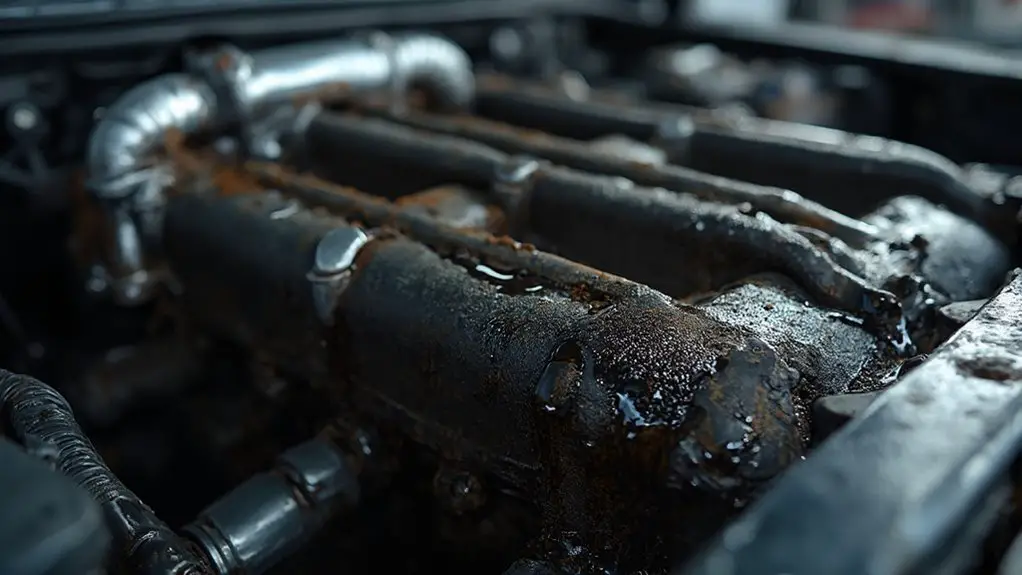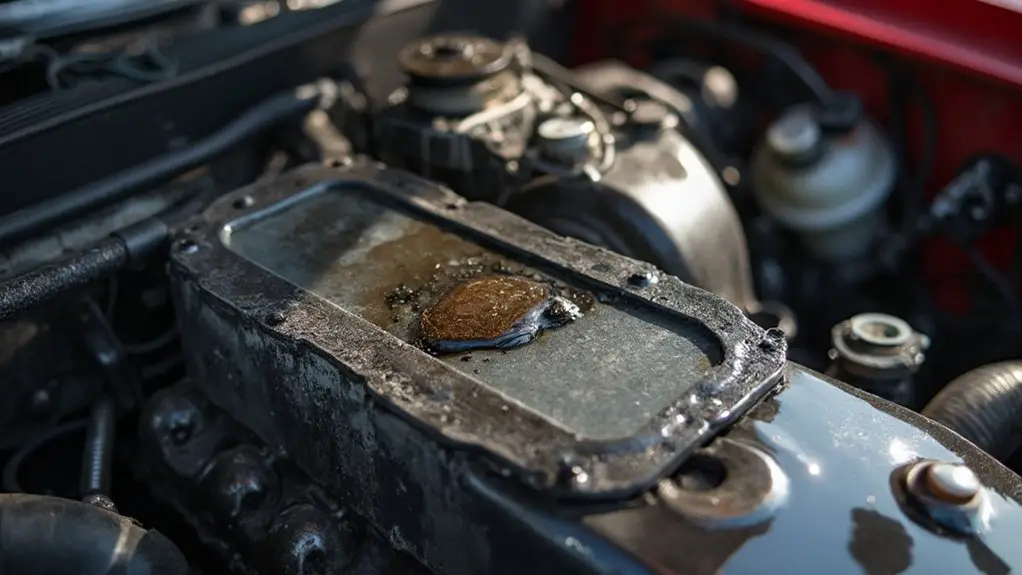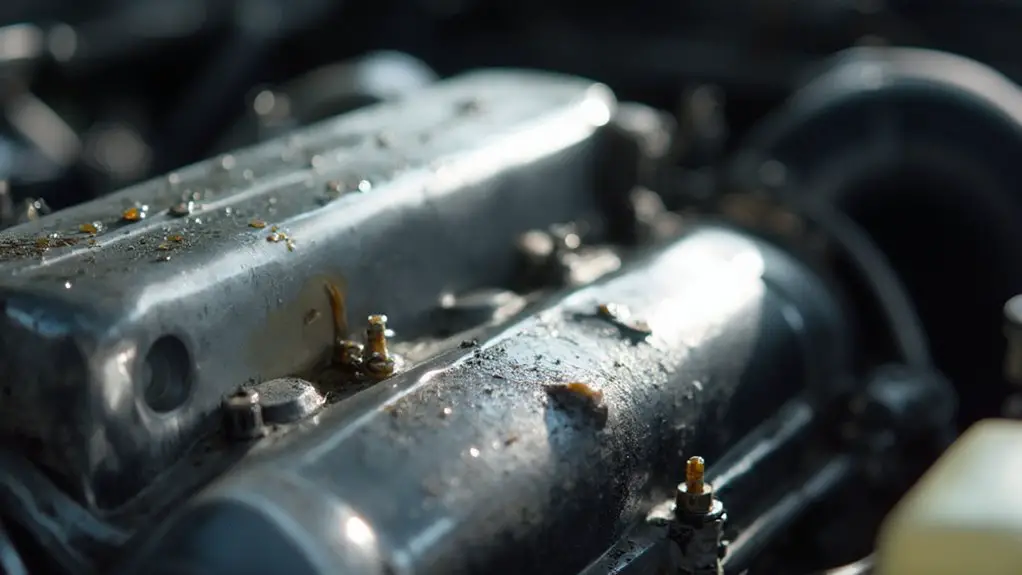Oil in your car's intake manifold usually signals an issue like a faulty PCV valve, leaky valve seals, or even a failing turbocharger. These problems can lead to engine smoke, power loss, or misfires. You might notice knocking sounds or fouled spark plugs, too. Fixing these issues can range from simple repairs to more complex ones. Want to know about symptoms, repair options, and preventive maintenance? There's plenty more to explore!
Common Causes of Oil in the Intake Manifold
When you notice oil in your car's intake manifold, it's crucial to identify the common causes behind it. A bad PCV valve can allow oil entry, creating issues.
Clogged oil passages might also lead to oil accumulation in the manifold. Additionally, leaking valve seals can permit oil infiltration, causing further complications.
If you have a turbocharged engine, a failing turbocharger could introduce oil into the intake as well.
While small amounts of oil are normal, excessive flooding is a concern and indicates a more significant problem that needs addressing.
Stay proactive to prevent engine damage and costly repairs.
Identifying Symptoms of Oil Contamination
Identifying symptoms of oil contamination in your vehicle is essential for maintaining engine health. Look for engine smoke, as this can indicate oil presence. You might notice reduced engine power or misfiring, which are also warning signs. Additionally, fouled spark plugs could result from oil contamination. Regularly checking these symptoms can help catch issues early.
| Symptom | Description | Action Needed |
|---|---|---|
| Engine Smoke | Visible smoke from the exhaust | Inspect for oil leaks |
| Reduced Power | Noticeable loss of acceleration | Check engine performance |
| Misfiring Engine | Irregular engine operation | Diagnose ignition system |
| Fouled Spark Plugs | Excessive oil on spark plugs | Replace spark plugs |
| Unusual Engine Noise | Knocking or tapping sounds | Investigate engine internals |
Repair Options for Addressing Oil Issues
Detecting symptoms of oil contamination is just the first step in resolving the issue.
To tackle this problem, start by cleaning or repairing the PCV valve, which is often a simple fix. If a failing turbocharger is to blame, you might need to replace it.
Leaky valve seals can be addressed through replacement, while worn piston rings will require more complex and costly repairs.
Cleaning clogged oil passages demands significant effort and expertise, so consider consulting a professional.
Taking these steps can help restore your engine's performance and prevent further oil infiltration into the intake manifold.
Detailed Methods for Repairing Oil Infiltration
To effectively tackle oil infiltration in your car's intake manifold, you'll need to employ specific repair methods tailored to the underlying cause.
If the PCV valve is the culprit, clean and inspect it thoroughly.
For valve seal leaks, you can replace them by accessing the engine head.
If your turbocharger is failing, prepare for a replacement, costing between $750 and $1,250.
For more severe issues like piston ring failure, be ready for a complex repair that could cost up to $5,000.
Finally, cleaning clogged oil passages will require removing engine components and meticulous handling for effective results.
Maintenance Tips to Prevent Oil Accumulation
Regular maintenance is key to preventing oil accumulation in your car's intake manifold, as it helps keep your engine running smoothly. To guarantee peak performance, follow these tips:
| Maintenance Task | Frequency |
|---|---|
| Change engine oil | Every 5,000 miles |
| Inspect PCV valve | Every oil change |
| Check valve seals | Every 15,000 miles |
Frequently Asked Questions
Can I Drive My Car With Oil in the Intake Manifold?
You shouldn't drive your car with oil in the intake manifold. It can cause engine damage, reduced performance, and potential misfiring. Get it checked immediately to avoid further complications and costly repairs down the line.
How Can I Tell if Oil Is From the Engine or Turbo?
To determine if the oil's from the engine or turbo, inspect for leaks around the turbocharger. Check for excessive oil in the intake and monitor engine performance. A mechanic's evaluation can provide clarity on the source.
Will Oil in the Intake Manifold Void My Warranty?
Oil in your intake manifold might void your warranty, especially if it's linked to improper maintenance or a manufacturer's defect. Check your warranty terms and consult with your dealer to understand potential implications.
What Are the Long-Term Effects of Oil in the Intake?
Oil in your intake can lead to long-term engine damage, reduced performance, and increased emissions. It might cause fouled spark plugs and misfires, ultimately resulting in costly repairs if not addressed promptly. Regular maintenance helps prevent this.
Are There Specific Brands More Prone to This Issue?
Certain brands, like those with turbocharged engines or specific designs, might experience more oil in the intake manifold. Regular maintenance and monitoring can help you avoid these issues and keep your engine running smoothly.


